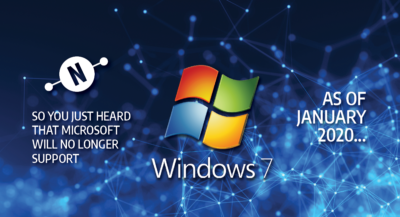Windows 7: It’s Time to Upgrade!
Posted on Tuesday, May 27, 2025 and filed under Articles

Is your business still using Windows 7? It’s time to switch to Windows 10. Microsoft is going to end the support for Windows 7 as early as January 2020, and that isn’t the only reason you should consider upgrading.
Most peripherals do not work with Windows 7 anymore, and it’s difficult to find new or fixed drivers. A good number of businesses have already finished the migration.
Microsoft is soon going to start displaying pop-up notifications on Windows 7 computer systems that its time to get going – the clock is ticking.
If you don’t want to migrate, think about this. Without extended support, your business could face more ransomware attacks, and the costs of cleaning up wouldn’t be small.
What if You Still Don’t Want to Upgrade?
If you still plan to cling on Windows 7, the extended support options will cost you a bomb. However, Microsoft through Microsoft Windows Virtual Desktop has offered extended support or paid Windows 7 Extended Security Updates. The free card provides 3 years of free extended support and can cost you as less as $50 per device, according to some reports.
Also, you may want to switch over to Linux. However, the compatibility related issues to your apps could be many, and most businesses that have waited until now, have already considered it. You could wait till January 2020, when Windows stops all updates. However, you’d be opening a can of worms then, and one you wouldn’t like. If you do need any PC to run on Windows 7, it’s a good idea to disconnect it from all networks.
The Top Reasons Why You Shouldn’t Wait to Migrate
The Windows 10 OS, the latest offering from Microsoft, has some great benefits you wouldn’t find with your current operating system. Here is a look.
- It’s STILL Free
Windows 10 is still actually free to upgrade. Though Microsoft discontinued the free upgrade option back in 2016, it’s still technically possible to upgrade to the new OS, and here is how you can do it. Of course, hardware replacement – which should be what you need to look for any devices beyond five years – is the easiest way to get Windows 10.
- You Don’t Need to Upgrade Again
Microsoft has pretty much said that the Windows 10 is technically going to be the last version of Windows. All the new things that you’ll get to experience on Windows will come as updates, rather than a different OS.
- Improved Security
Windows 10, with Windows Defender built-in, does have better security than previous versions. Sure, you may want to buy in additional security, but it’s another reason why you should upgrade to Windows 10.
- You Will No Longer Get Any Support
Windows 7 mainstream support was revoked in 2015, and the extended support is ending in 2020, as we talked above.
- Is Great If You Need High-End Graphic Cards
Windows 10 supports DirectX12, and this is good news for many gaming businesses. DirectX 12 helps game developers to access hardware better, helping test run games more efficiently. The new versions of DirectX 12 also allows more features for developers.
- Updates Every Once a While
No, we aren’t talking about the daily updates. Microsoft says that Windows 10 will receive a significant update every six months.
Which Windows 10 Version Should You Upgrade to?
Now, many businesses believe the Windows 10 Pro is the obvious choice. I suggest spending a few extra bucks and going in for the Windows 10 Enterprise edition. It offers more support schedule – as long as 30 months compared to the 18 months of the pro edition – and also provides new support called Desktop App Assure. The feature has the Microsoft engineering team having your back if you face any compatibility issue while upgrading.
It isn’t easy to migrate from Windows 7 to Windows 10 all at once. Here is what you may want to do.
- Don’t upgrade all at once. Keep some of the Windows 7 computers still in operation and migrate some to Windows 10. It will ensure you don’t disrupt the workflow.
- Educate your employees and end users on your daily or weekly upgrade schedule, so that everyone stays in the loop.
Businesses that have already migrated to the new version of Windows haven’t faced significant issues. Don’t just wait for the deadline to approach, pull up your socks and start planning. It’s time to join the race.
Someone from our sales staff will contact you shortly to set up your free data backup system audit.